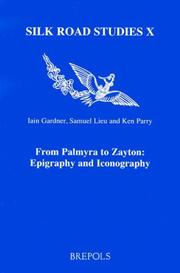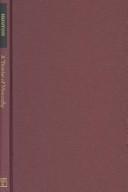| Listing 1 - 10 of 21 | << page >> |
Sort by
|

ISBN: 2503518834 9782503518831 Year: 2005 Volume: 10 Publisher: Turnhout Brepols
Abstract | Keywords | Export | Availability | Bookmark
 Loading...
Loading...Choose an application
- Reference Manager
- EndNote
- RefWorks (Direct export to RefWorks)
China --- Chine --- Epigrafie --- Epigraphie --- Iconografie --- Iconographie --- Syrie --- Syrië --- Inscriptions --- S03/0450 --- S13B/0300 --- China: Geography, description and travel--Silk route --- China: Christianity--Nestorianism (incl. Christianity before 17th century)
Book
ISSN: 09292470 ISBN: 9004102485 9789004322592 9004322590 9789004328914 9004328912 9789004102484 Year: 1995 Volume: 37 Publisher: Leiden: New York: E.J. Brill,
Abstract | Keywords | Export | Availability | Bookmark
 Loading...
Loading...Choose an application
- Reference Manager
- EndNote
- RefWorks (Direct export to RefWorks)
The Kephalaia of the Teacher is the most detailed account available to modern scholarship of the teachings of Mani, and of the universal religion that he founded as the final successor to Buddha, Zarathushtra and Jesus. This volume provides the first complete English translation of the Coptic text (c. 400 CE), together with an introduction, commentaries and indices. Topics include the apostleship of Mani, the practices of the Manichaean community, accounts of the heavenly and demonic beings and worlds, as well as discussions of astrology and religious psychology. In Manichaeism many of the gnostic and dualistic themes of early Christianity achieved the status of a world religion, and the subject is the heir to contemporary interest in heterodoxy and the deconstruction of received histories (see the Nag Hammadi codices)
Manichaeism --- Early works to 1800. --- 091 =932 --- 273.1*35 --- 273.21 --- -Dualism (Religion) --- Philosophy, Ancient --- Handschriftenkunde. Handschriftencatalogi--Koptisch --- Gnosis: Koptische bronnen: Nag Hammadi; Codex Jung; Evangelium veritatis --- Manicheïsme --- Early works to 1800 --- Christianity --- -Handschriftenkunde. Handschriftencatalogi--Koptisch --- 273.21 Manicheïsme --- 273.1*35 Gnosis: Koptische bronnen: Nag Hammadi; Codex Jung; Evangelium veritatis --- 091 =932 Handschriftenkunde. Handschriftencatalogi--Koptisch --- Dualism (Religion) --- Mani, --- Manes, --- Manichaeus, --- مانى --- Manichaeism - Early works to 1800 --- Manichaeism - Sources --- Mani, - active 3rd century
Book
ISBN: 1108599451 1108614965 1108499074 1108585736 Year: 2020 Publisher: Cambridge : Cambridge University Press,
Abstract | Keywords | Export | Availability | Bookmark
 Loading...
Loading...Choose an application
- Reference Manager
- EndNote
- RefWorks (Direct export to RefWorks)
Mani, a third-century preacher, healer and public sage from Sasanian Mesopotamia, lived at a pivotal time and place in the development of the major religions. He frequented the courts of the Persian Empire, debating with rivals from the Judaeo-Christian tradition, philosophers and gnostics, Zoroastrians from Iran and Buddhists from India. The community he founded spread from north Africa to south China and lasted for over a thousand years. Yet the genuine biography of its founder, his life and thought, was in good part lost until a series of spectacular discoveries have begun to transform our knowledge of Mani's crucial role in the spread of religious ideas and practices along the trade-routes of Eurasia. This book utilises the latest historical and textual research to examine how Mani was remembered by his followers, caricatured by his opponents, and has been invented and re-invented according to the vagaries of scholarly fashion.
Mani, --- Manes, --- Manichaeus, --- مانى --- Manichaeism --- Dualism (Religion) --- Philosophy, Ancient --- Christianity
Multi
ISBN: 9781108614962 9781108499071 9781108713115 Year: 2020 Publisher: Cambridge Cambridge University Press
Abstract | Keywords | Export | Availability | Bookmark
 Loading...
Loading...Choose an application
- Reference Manager
- EndNote
- RefWorks (Direct export to RefWorks)
Article
Year: 1993
Abstract | Keywords | Export | Availability | Bookmark
 Loading...
Loading...Choose an application
- Reference Manager
- EndNote
- RefWorks (Direct export to RefWorks)
Article
Year: 1993
Abstract | Keywords | Export | Availability | Bookmark
 Loading...
Loading...Choose an application
- Reference Manager
- EndNote
- RefWorks (Direct export to RefWorks)
Book
ISBN: 9782503531700 2503531709 Year: 2013 Volume: 1 Publisher: Turnhout: Brepols,
Abstract | Keywords | Export | Availability | Bookmark
 Loading...
Loading...Choose an application
- Reference Manager
- EndNote
- RefWorks (Direct export to RefWorks)
This volume publishes a new Coptic handbook of ritual power, comprising a complete 20 page parchment codex from the second half of the first millennium AD. It consists of an invocation including both Christian and Gnostic elements, ritual instructions, and a list of twenty-seven spells to cure demonic possession, various ailments, the effects of magic, or to bring success in love and business. The codex is not only a substantial new addition to the corpus of magical texts from Egypt, but, in its opening invocation, also provides new evidence for Sethian Gnostic thought in Coptic texts.
Coptic magic --- Early works to 1800 --- Incantations --- Charms --- Coptic manuscripts (Papyri) --- Australia --- Sydney (N.S.W.) --- Coptic language --- Manuscripts (Papyri) --- Koptische handschriften. --- Macquarie University. --- Coptic manuscripts --- Manuscrits coptes --- Magie copte --- Coptic magic - Early works to 1800 --- Incantations - Early works to 1800 --- Charms - Early works to 1800 --- Coptic manuscripts (Papyri) - Australia - Sydney (N.S.W.)

Abstract | Keywords | Export | Availability | Bookmark
 Loading...
Loading...Choose an application
- Reference Manager
- EndNote
- RefWorks (Direct export to RefWorks)
Book
ISBN: 9783170416727 3170416723 Year: 2022 Publisher: Stuttgart Kohlhammer
Abstract | Keywords | Export | Availability | Bookmark
 Loading...
Loading...Choose an application
- Reference Manager
- EndNote
- RefWorks (Direct export to RefWorks)
Volume 2 of the series "Manichäische Handschriften" presents a critical edition of the remains of Mani's Letters as preserved in Berlin P.15998, together with pages now housed in Warsaw. The Coptic text is provided with an English translation, and the volume includes an introduction to the codex, its history and selected photographs of the papyrus. A link to the latest multispectral images will be given.
Book
ISBN: 9781108713115 9781108499071 Year: 2019 Publisher: New York : Cambridge University Press,
Abstract | Keywords | Export | Availability | Bookmark
 Loading...
Loading...Choose an application
- Reference Manager
- EndNote
- RefWorks (Direct export to RefWorks)
"Mani, a third-century preacher, healer and public sage from Sasanian Mesopotamia, lived at a pivotal time and place in the development of the major religions. He frequented the courts of the Persian Empire, debating with rivals from the Judaeo-Christian tradition, philosophers and gnostics, Zoroastrians from Iran and Buddhists from India. The community he founded spread from north Africa to south China and lasted for over a thousand years. Yet the genuine biography of its founder, his life and thought, was in good part lost until a series of spectacular discoveries have begun to transform our knowledge of Mani's crucial role in the spread of religious ideas and practices along the trade-routes of Eurasia. This book utilises the latest historical and textual research to examine how Mani was remembered by his followers, caricatured by his opponents, and has been invented and reinvented according to the vagaries of scholarly fashion"--
Manichaeism --- Mani,
| Listing 1 - 10 of 21 | << page >> |
Sort by
|

 Search
Search Feedback
Feedback About UniCat
About UniCat  Help
Help News
News